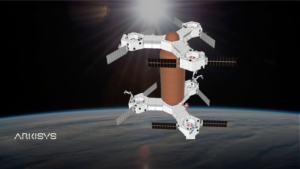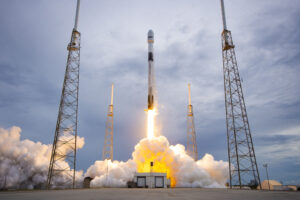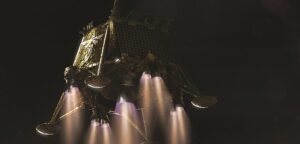Four-legged jumping robots to explore the moon
Wednesday, 21 September 2022 17:24
A four-legged robot trained through artificial intelligence has learned the same lesson as the Apollo astronauts—that jumping can be the best way to move around on the surface the moon. An update on LEAP (Legged Exploration of the Aristarchus Plateau), a mission concept study supported by ESA to explore some of the most challenging lunar terrains, has been presented today at the Europlanet Science Congress (EPSC) 2022 in Granada by Patrick Bambach.
"LEAP's target is the Aristarchus plateau, a region of the moon that is particularly rich in geologic features but highly challenging to access," said Patrick Bambach of the Max Planck Institute for Solar System Research in Germany. "With the robot, we can investigate key features to study the geologic history and evolution of the moon, like the ejecta around craters, fresh impact sites, and collapsed lava tubes, where material may not have been altered by space weathering and other processes.
First 3D renders from JunoCam data reveal 'frosted cupcake' clouds on Jupiter
Wednesday, 21 September 2022 16:52
A virtual hiking map for Jezero crater, the Mars 2020 Perseverance rover landing site
Wednesday, 21 September 2022 16:51
Prospective Mars explorers can now take a hike around the landing site of NASA's Mars 2020 Perseverance rover with an interactive map loaded with orbital imagery, terrain data as well as synthetic and real 3D panoramic views of Jezero crater and its surrounding area. The map, which can be accessed through a normal web browser, has been presented today at the Europlanet Science Congress (EPSC) 2022 in Granada, Spain, by Sebastian Walter of the Freie Universität Berlin.
"The map is the perfect tool for planning a future visit to Mars, with an interactive interface where you can choose from different available base datasets. Some of the slopes are pretty steep, so watch out for those if you want to avoid too much oxygen consumption!" said Sebastian Walter.
"To get a real feeling of what to expect on your future Mars trip, you can click on one of the waypoint marker symbols to enter either a fullscreen 3D view or, if you have a Virtual Reality setup, to enter a fully immersive environment.
Arkisys’ first flight to demonstrate universal interface adapter
Wednesday, 21 September 2022 15:30
Arkisys plans to launch Applique, a universal interface adapter designed to connect any spacecraft payload, using a variety of common interface standards and protocols.
The post Arkisys’ first flight to demonstrate universal interface adapter appeared first on SpaceNews.
Spaced Ventures petition for SpaceX shares hits $11.4 million
Wednesday, 21 September 2022 14:32
In a little over a week, the crowdfunding platform Spaced Ventures has obtained pledges of $11.4 million from 758 individuals eager to invest in SpaceX.
The post Spaced Ventures petition for SpaceX shares hits $11.4 million appeared first on SpaceNews.
Mars is littered with 15,694 pounds of human trash from 50 years of robotic exploration
Wednesday, 21 September 2022 14:27
People have been exploring the surface of Mars for over 50 years. According to the United Nations Office for Outer Space Affairs, nations have sent 18 human-made objects to Mars over 14 separate missions. Many of these missions are still ongoing, but over the decades of Martian exploration, humankind has left behind many pieces of debris on the planet's surface.
I am a postdoctoral research fellow who studies ways to track Mars and Moon rovers. In mid-August 2022, NASA confirmed that the Mars rover Perseverance had spotted a piece of trash jettisoned during its landing, this time a tangled mess of netting. And this is not the first time scientists have found trash on Mars. That's because there is a lot there.
New Webb image captures clearest view of Neptune's rings in decades
Wednesday, 21 September 2022 14:02
Lander companies prepare to shoot for the moon
Wednesday, 21 September 2022 13:54
The first launches of commercial landers to the moon under CLPS are slated late this year or early next, marking an important milestone for a 2018 NASA program that saw one of its awardees file for bankruptcy this summer.
NASA fuels moon rocket in leak test ahead of next launch try
Wednesday, 21 September 2022 13:21
NASA tries fueling moon rocket in test, but leak reoccurs (Update)
Wednesday, 21 September 2022 13:21
NASA fuels moon rocket in test, hit again with pesky leaks
Wednesday, 21 September 2022 13:21
Weightless on Earth: Preparing astronauts for microgravity
Wednesday, 21 September 2022 12:38
Webb captures clearest view of Neptune's rings in decades
Wednesday, 21 September 2022 12:30 NASA's James Webb Space Telescope shows off its capabilities closer to home with its first image of Neptune. Not only has Webb captured the clearest view of this distant planet's rings in more than 30 years, but its cameras reveal the ice giant in a whole new light.
Most striking in Webb's new image is the crisp view of the planet's rings - some of which have not been detected since NASA's
NASA's James Webb Space Telescope shows off its capabilities closer to home with its first image of Neptune. Not only has Webb captured the clearest view of this distant planet's rings in more than 30 years, but its cameras reveal the ice giant in a whole new light.
Most striking in Webb's new image is the crisp view of the planet's rings - some of which have not been detected since NASA's SAIC and Rogue Space Systems partner to deliver services for objects orbiting Earth
Wednesday, 21 September 2022 12:30 Science Applications International Corp. (NYSE: SAIC) and Rogue Space Systems Corporation has announced a strategic partnership to develop solutions that provide rapidly deliverable In-Orbit Service Assembly and Manufacturing (ISAM), asset inspection and Space Situational Awareness (SSA).
"Together, SAIC and Rogue bring unique skills and expertise that will support the growing demand for s
Science Applications International Corp. (NYSE: SAIC) and Rogue Space Systems Corporation has announced a strategic partnership to develop solutions that provide rapidly deliverable In-Orbit Service Assembly and Manufacturing (ISAM), asset inspection and Space Situational Awareness (SSA).
"Together, SAIC and Rogue bring unique skills and expertise that will support the growing demand for s Harnessing new propulsion technology for Earth monitoring
Wednesday, 21 September 2022 12:30 The reliability of any satellite depends on the quality of all its parts. With supply chains changing in light of world events, Airbus is looking at alternative European-sourced satellite equipments that will also introduce innovations.
During the world's most prominent space industry gathering, the International Astronautical Congress, Airbus and Exotrail inked an agreement for integratio
The reliability of any satellite depends on the quality of all its parts. With supply chains changing in light of world events, Airbus is looking at alternative European-sourced satellite equipments that will also introduce innovations.
During the world's most prominent space industry gathering, the International Astronautical Congress, Airbus and Exotrail inked an agreement for integratio 
